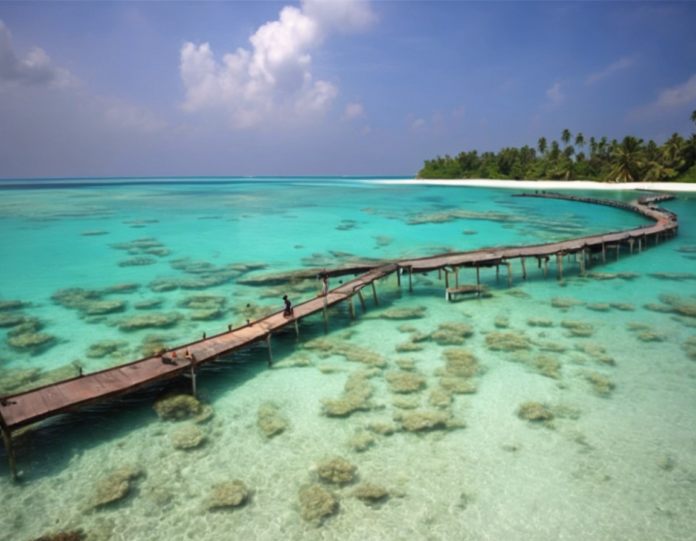Nestled in the crystalline waters of the Arabian Sea, the archipelago of Lakshadweep stands as a pristine gem of India’s marine biodiversity. Comprising 36 islands, only a handful of which are inhabited, this remote destination offers a breathtaking escape for those seeking serenity, natural beauty, and adventure. With its stunning coral reefs, azure lagoons, and rich marine life, Lakshadweep is a true paradise for nature enthusiasts and underwater explorers alike. In this comprehensive guide, we will delve into the wonders of Lakshadweep, exploring its history, geography, marine ecosystems, tourism offerings, and conservation efforts.
History and Geography
Lakshadweep, which translates to “a hundred thousand islands” in Malayalam, has a history shrouded in myth and legend. Believed to have been first settled by the Arabs in the 7th century, the islands came under the rule of various dynasties, including the Cholas, Kolathiris, and the Ali Rajahs of Cannanore. In the 16th century, Portuguese explorer Vasco da Gama visited the archipelago, which later became part of the British colonial empire. After India gained independence in 1947, Lakshadweep was incorporated into the Indian union in 1956.
Located off the southwestern coast of India, about 200 to 400 kilometers from the state of Kerala, Lakshadweep is a group of coral islands formed atop a vast underwater mountain range. The islands are divided into three geographical subgroups: Amindivi, Laccadive, and the uninhabited Minicoy islands. The atolls and reefs of Lakshadweep are unique ecosystems that support a diverse array of marine species, making it a key area for maritime biodiversity and conservation efforts.
Marine Ecosystems and Biodiversity
At the heart of Lakshadweep’s allure lies its vibrant and diverse marine ecosystems, which are home to a plethora of marine species, including colorful corals, tropical fish, sea turtles, and dolphins. The coral reefs of Lakshadweep are among the most biodiverse in the world, with over 600 species of fish and other marine organisms inhabiting its waters.
The coral reefs of Lakshadweep serve as crucial habitats for a variety of marine life, providing shelter, food, and breeding grounds for numerous species. The islands also boast expansive seagrass meadows, mangrove forests, and lagoons teeming with life. Visitors to Lakshadweep have the opportunity to witness this rich biodiversity up close through activities such as snorkeling, scuba diving, and glass-bottom boat rides.
Tourism Offerings
Lakshadweep offers a range of tourism experiences for visitors seeking to explore its natural beauty and cultural heritage. The islands are renowned for their pristine beaches, clear waters, and abundant marine life, making them an ideal destination for eco-tourism and water sports enthusiasts. Visitors can engage in activities such as snorkeling, scuba diving, kayaking, sailing, and fishing, allowing them to immerse themselves in the unspoiled natural surroundings of the archipelago.
For those seeking a more relaxed experience, the islands of Lakshadweep offer luxury resorts and beachfront cottages where guests can unwind and enjoy the tranquility of their surroundings. Local cuisine, traditional dance performances, and cultural tours provide visitors with a glimpse into the unique heritage of the islands and their inhabitants.
Conservation Efforts
As a fragile and vulnerable ecosystem, the marine biodiversity of Lakshadweep faces numerous threats, including climate change, overfishing, pollution, and coastal development. Recognizing the importance of preserving this natural treasure, the government of India, in collaboration with local communities and environmental organizations, has implemented various conservation measures to protect the marine ecosystems of the archipelago.
Efforts such as marine protected areas, sustainable fishing practices, waste management initiatives, and public awareness campaigns are aimed at safeguarding the biodiversity of Lakshadweep for future generations. By promoting responsible tourism and community involvement, these conservation initiatives seek to strike a balance between environmental protection and economic development in the region.
Frequently Asked Questions (FAQs)
-
Q: What is the best time to visit Lakshadweep?
A: The best time to visit Lakshadweep is during the months of October to May, when the weather is pleasant and ideal for outdoor activities. -
Q: Do I need a permit to visit Lakshadweep?
A: Yes, visitors to Lakshadweep require a permit issued by the Lakshadweep administration, which can be obtained through authorized tour operators. -
Q: Is scuba diving allowed in Lakshadweep?
A: Yes, scuba diving is permitted in designated areas in Lakshadweep under the supervision of certified instructors. -
Q: Are there any restrictions on fishing in Lakshadweep?
A: Fishing regulations exist in Lakshadweep to prevent overfishing and protect marine biodiversity. Visitors are advised to follow local guidelines. -
Q: Are there accommodations available on all the islands of Lakshadweep?
A: Accommodations are primarily available on the inhabited islands of Lakshadweep, with varying options ranging from budget guesthouses to luxury resorts.
In conclusion, Lakshadweep stands as a testament to the natural beauty and ecological importance of India’s marine heritage. With its enchanting coral reefs, pristine beaches, and vibrant marine life, the archipelago offers a unique opportunity for visitors to immerse themselves in an unspoiled tropical paradise. By promoting sustainable tourism practices and conservation efforts, we can ensure that the incomparable wonders of Lakshadweep continue to thrive for generations to come.

